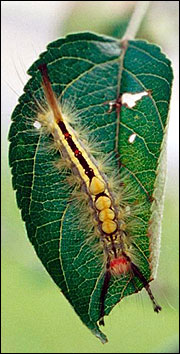Whitemarked tussock moth
Tussock moths
 Whitemarked tussock moth caterpillars (Orgyia leucostigma) are present from May to October. They produce two generations per year.
Whitemarked tussock moth caterpillars (Orgyia leucostigma) are present from May to October. They produce two generations per year.
Full-grown whitemarked tussock moth caterpillars are 1 to 1.5 inches long. Arising laterally on each side of the first thoracic segment (which is red) is a group (or pencil) of long black hairs that point forward past the red head. Similarly, a single group of backward-pointing, black hairs arises at the end of the abdomen. On top of the first four abdominal segments is a densely packed tuft of yellow or white hairs, and on the remaining abdominal segments is a longitudinal black line of short hairs bordered by yellow hairs. In the center of this black line on the sixth and seventh abdominal segments is a bright red spot. On each side of the body are tufts of white-yellow and black hairs arising from a row of tubercles. Host plants include many hardwoods and conifers, with preference to apple, basswood, elm, poplar and maples.
About the family
Some of our most destructive forest pests are caterpillars from the Lymantriidae family, which are often characterized as being very hairy. These hairs, often in a densely clumped “tussock” or a small or elongated brush (called a pencil) are found arising in specific locations, patterns and colors; they can be stinging or irritating (urticating) when handled or touched by people with sensitive skin.